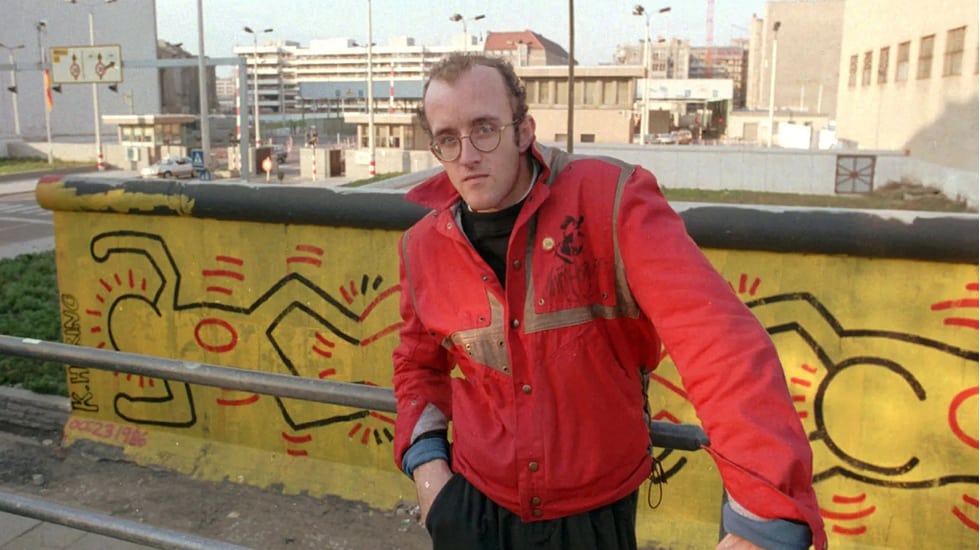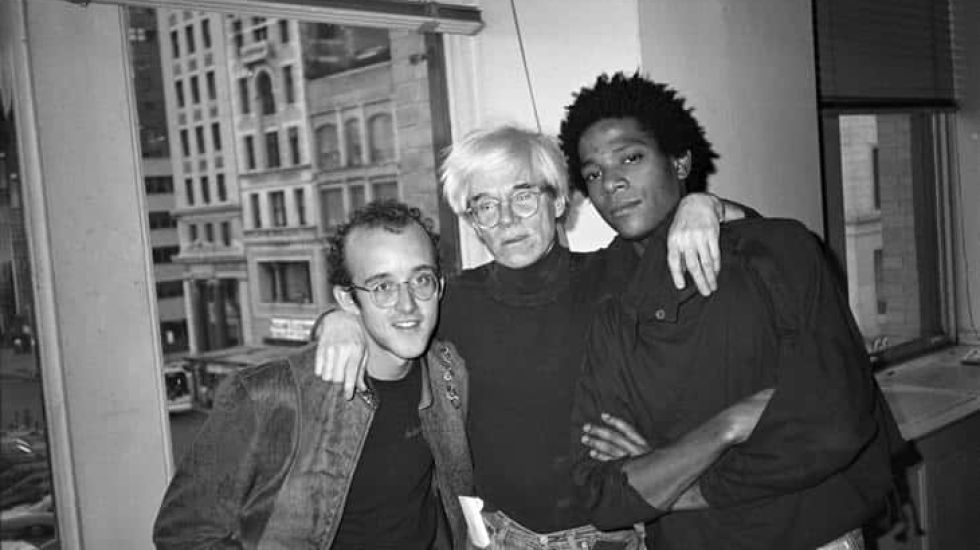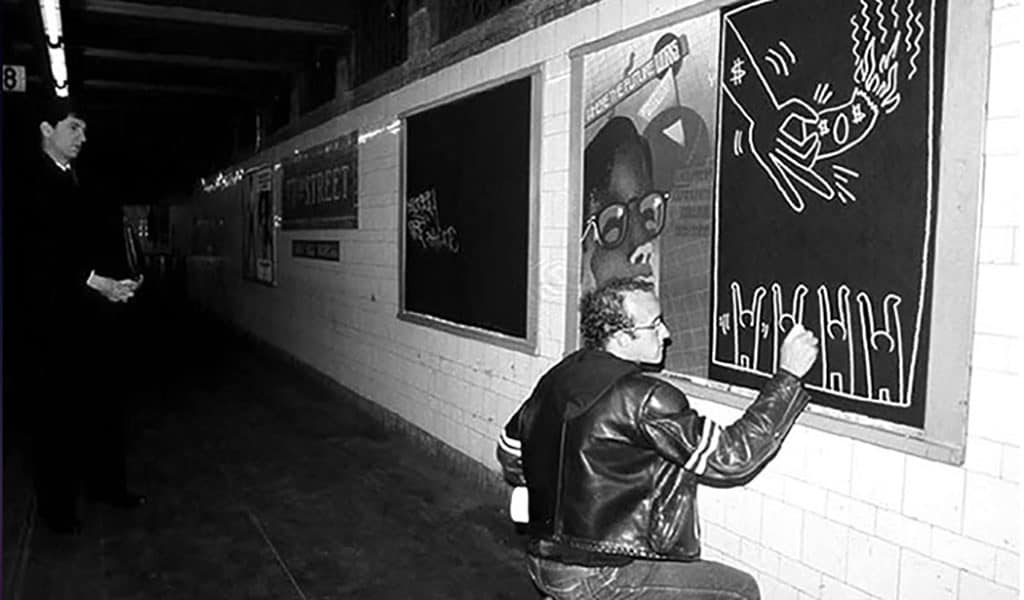

Keith Haring was born in Reading, Pennsylvania, on May 4, 1958. He grew up in the nearby town of Kutztown, Pennsylvania. He loved to draw from a very young age. He learned the basics of cartooning from his father and from things like Dr. Seuss and Walt Disney that were popular at the time.
When Haring finished high school in 1976, he went to the Ivy School of Professional Art in Pittsburgh, which was a school for commercial art. He soon realized that he didn't want to be a commercial graphic artist, so he quit school after two semesters. Haring continued to study and work on his own while he was in Pittsburgh. In 1978, he had a one-man show at the Pittsburgh Arts and Crafts Center.
Later that same year, Haring moved to New York City and enrolled at the School of Visual Arts (SVA). Haring found a thriving alternative art scene in New York that was growing outside of galleries and museums, on the streets, in the subways, and in clubs and old dance halls. Here, he met other artists like Kenny Scharf and Jean-Michel Basquiat, as well as musicians, performance artists, and graffiti writers who were part of the growing art community. Haring got caught up in the energy and spirit of this scene and started putting on shows and performances at Club 57 and other non-traditional venues.
Haring was inspired by the work of Jean Dubuffet, Pierre Alechinsky, William Burroughs, Brion Gysin, and Robert Henri's manifesto The Art Spirit, which argued for the fundamental independence of the artist. He was also impressed by the creativity and energy of his peers. Haring was able to channel his own young desires into a unique form of graphic expression based on the line. Haring was also inspired by the public and participatory nature of Christo's work, especially Running Fence, and by Andy Warhol's unique way of mixing art and life. These things made him want to spend his whole life making art that everyone could enjoy.

Haring tried out performance, video, installation, and collage while he was a student at SVA, but he never gave up on drawing. In 1980, when he saw matte black paper covering unused advertising panels in a subway station, Haring found a very effective way to reach a wider audience and say what he wanted to say. He began to draw on these blank paper panels all over the subway system with white chalk. Between 1980 and 1985, Haring made a lot of these public drawings with quick, rhythmic lines. Some days, he made as many as forty "subway drawings." New York commuters got used to this smooth flow of images and would often stop to talk to the artist when they saw him at work. Haring called the subway a "laboratory" where he worked out his ideas and tried out his simple lines.

Between 1980 and 1989, Haring became known all over the world and took part in many group and solo shows. In 1981, his first one-man show in New York was at the Westbeth Painters Space. In 1982, he had his first show in a Soho gallery. It was a one-man show at the Tony Shafrazi Gallery, and it was a huge success. During this time, he also took part in well-known international survey shows like Documenta 7 in Kassel, the So Paulo Biennial, and the Whitney Biennial. Haring also did a lot of public work in the first half of the 1980s. He made an animation for the Spectacolor billboard in Times Square, designed sets and backdrops for theaters and clubs, made watch designs for Swatch and an ad campaign for Absolut vodka, and painted murals all over the world.
Haring opened the Pop Shop in Soho in April 1986. It sold T-shirts, toys, posters, buttons, and magnets with his designs on them. Haring thought of the shop as an extension of his work, so he painted an abstract black-and-white mural on the whole inside, making it a striking and unique place to shop. The shop was meant to make it easier for people to get his work, which was now easy to find on cheap products. Many people in the art world didn't like the shop, but Haring stayed true to his goal of making his art available to as many people as possible. His friends, fans, and mentors, like Andy Warhol, gave him strong support for his project.
Haring spent a lot of time on public works, which often had social messages, all through his career. Between 1982 and 1989, he made more than 50 public works of art in dozens of cities all over the world. Many of these works were made for charities, hospitals, day care centers, and orphanages. Along New York's FDR Drive, the now-famous Crack is Wack mural from 1986 has become a landmark. Haring also worked with 900 children on a mural for the 100th anniversary of the Statue of Liberty in 1986. In 1987, he painted a mural on the outside of Necker Children's Hospital in Paris, France, and three years before the Berlin Wall fell, he painted a mural on the western side of the wall. Haring also taught kids how to draw in schools and museums in New York, Amsterdam, London, Tokyo, and Bordeaux. He also made pictures for many literacy programs and other public service campaigns.
In 1988, Haring was told he had AIDS. In 1989, he set up the Keith Haring Foundation. Its goal was to give money and artwork to AIDS groups and children's programs, as well as to show more people Haring's work through exhibitions, publications, and licensing of his images. During the last few years of his life, Haring used his art to talk about his own illness and raise awareness and activism about AIDS.
During the 1980s, Haring had a short but busy career. His work was shown in over 100 solo and group shows. More than 40 newspaper and magazine articles were written about him in 1986 alone. He was often asked to work on projects with other people, and he did so with famous people like Madonna, Andy Warhol, Grace Jones, Bill T. Jones, William Burroughs, Timothy Leary, Jenny Holzer, and Yoko Onol. By showing universal ideas like birth, death, love, sex, and war through a focus on lines and a directness of message, Haring was able to reach a large audience and make sure that his images would be easy to understand and last for a long time. His images have become a visual language that everyone knows from the 20th century.
Keith Haring died on February 16, 1990. He was 31 years old. His death was caused by complications from AIDS. On May 4, 1990, more than 1,000 people went to a memorial service at the Cathedral of St. John the Divine in New York City.
Since his death, there have been several international shows about Haring's life and work. Keith Haring's work can be seen in the collections and shows of major museums all over the world.